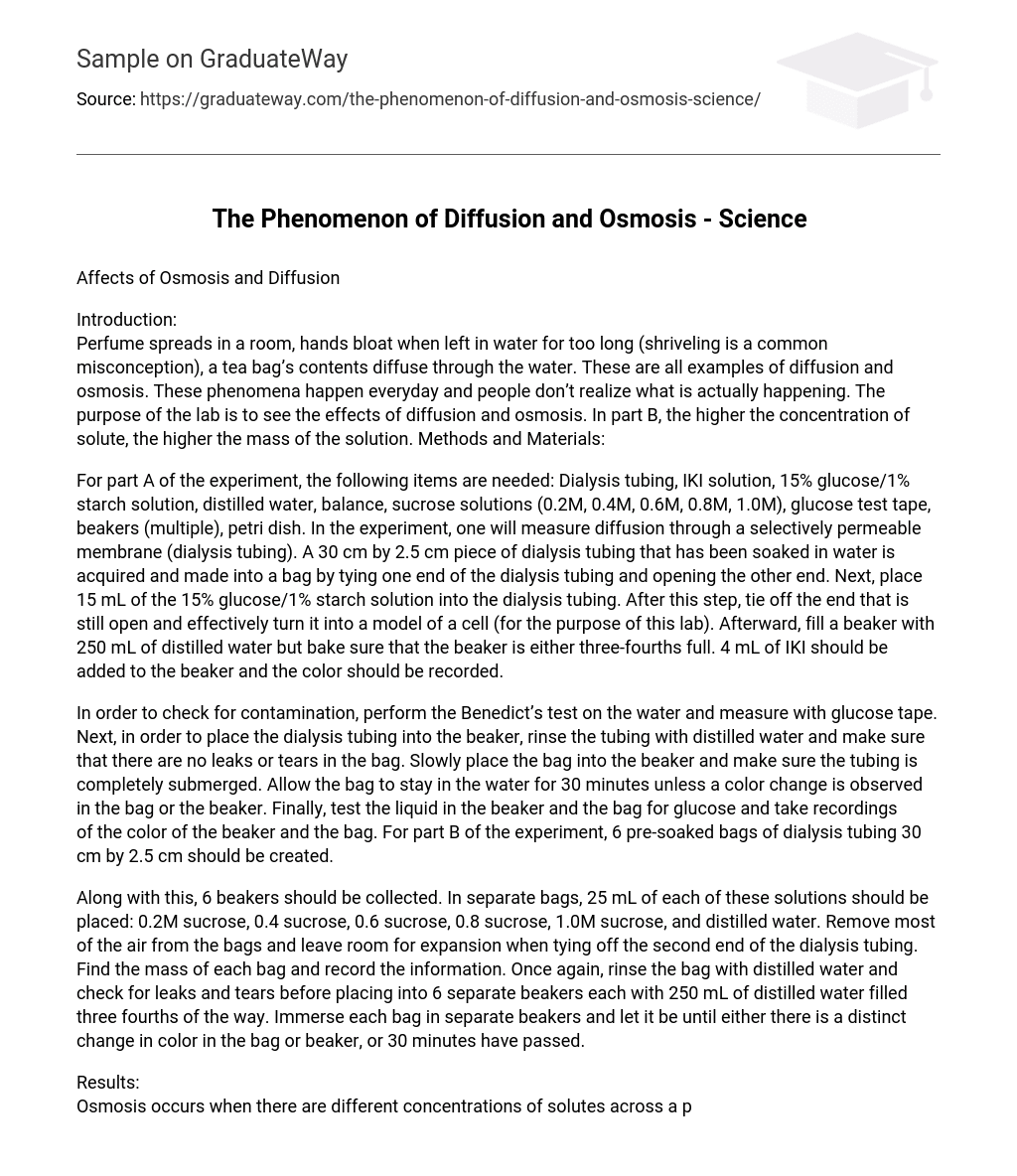Affects of Osmosis and Diffusion
Introduction:
Perfume spreads in a room, hands bloat when left in water for too long (shriveling is a common misconception), a tea bag’s contents diffuse through the water. These are all examples of diffusion and osmosis. These phenomena happen everyday and people don’t realize what is actually happening. The purpose of the lab is to see the effects of diffusion and osmosis. In part B, the higher the concentration of solute, the higher the mass of the solution. Methods and Materials:
For part A of the experiment, the following items are needed: Dialysis tubing, IKI solution, 15% glucose/1% starch solution, distilled water, balance, sucrose solutions (0.2M, 0.4M, 0.6M, 0.8M, 1.0M), glucose test tape, beakers (multiple), petri dish. In the experiment, one will measure diffusion through a selectively permeable membrane (dialysis tubing). A 30 cm by 2.5 cm piece of dialysis tubing that has been soaked in water is acquired and made into a bag by tying one end of the dialysis tubing and opening the other end. Next, place 15 mL of the 15% glucose/1% starch solution into the dialysis tubing. After this step, tie off the end that is still open and effectively turn it into a model of a cell (for the purpose of this lab). Afterward, fill a beaker with 250 mL of distilled water but bake sure that the beaker is either three-fourths full. 4 mL of IKI should be added to the beaker and the color should be recorded.
In order to check for contamination, perform the Benedict’s test on the water and measure with glucose tape. Next, in order to place the dialysis tubing into the beaker, rinse the tubing with distilled water and make sure that there are no leaks or tears in the bag. Slowly place the bag into the beaker and make sure the tubing is completely submerged. Allow the bag to stay in the water for 30 minutes unless a color change is observed in the bag or the beaker. Finally, test the liquid in the beaker and the bag for glucose and take recordings of the color of the beaker and the bag. For part B of the experiment, 6 pre-soaked bags of dialysis tubing 30 cm by 2.5 cm should be created.
Along with this, 6 beakers should be collected. In separate bags, 25 mL of each of these solutions should be placed: 0.2M sucrose, 0.4 sucrose, 0.6 sucrose, 0.8 sucrose, 1.0M sucrose, and distilled water. Remove most of the air from the bags and leave room for expansion when tying off the second end of the dialysis tubing. Find the mass of each bag and record the information. Once again, rinse the bag with distilled water and check for leaks and tears before placing into 6 separate beakers each with 250 mL of distilled water filled three fourths of the way. Immerse each bag in separate beakers and let it be until either there is a distinct change in color in the bag or beaker, or 30 minutes have passed.
Results:
Osmosis occurs when there are different concentrations of solutes across a permeable membrane. The dialysis tube served its function as a membrane and the results were acquired. In part A, osmosis was observed in the bag because the benedict’s solution entered through the dialysis tube and showed up as a blue tint at the top of the bag. The beaker remained a yellowish color from the IKI. Next part of the experiment, part B, was testing diffusion in various substances. In the distilled water, the change in mass was not drastic, although it was substantial. The 0.2M sucrose had a larger change in mass and the 0.4M sucrose had an even larger change in mass. The 0.6, 0.8, and 1.0M sucrose had about average change (13-17%).
Contents
Initial Mass
Final Mass
% Change in Mass
Distilled Water
21.94
23.92
9.02%
0.2M Sucrose
22.83
26.21
14.81%
0.4M Sucrose
22.94
28.81
25.59%
0.6M Sucrose
23.23
26.60
14.51%
0.8M Sucrose
23.63
26.99
14.22%
1.0M Sucrose
23.95
27.95
16.70%
Discussion:
The distilled water had less of a change in mass because the solute outside of the bag was lower. This caused there to be equilibrium that is easier to reach. The 0.2M sucrose increased in change in mass because the solute outside was much higher and existent unlike the distilled water. And an increase in the 0.4M sucrose happened for the same reason. The results for my classmates were mostly the same except we seemed to have an abnormality in the 0.6,0.8 and 1.0M sucrose. The results for this are completely off. Since osmosis is a process by which molecules of a solvent tend to pass through a semipermeable membrane from a less concentrated solution into a more concentrated one, thus equalizing the concentrations on each side of the membrane, the solution on the inside of the bag and the outside of the bag are equalized and the change in mass is correlated to this process. Diffusion works the same way, as osmosis only it is the passive movement of particles in an area. In part B of the experiment, this is exactly what we see in 2 instances.
The IKI is diffusing throughout the water in the beakerand because osmosis is but a type of diffusion, we also see the mass in the bag increase. The results were as expected in Part B. The water went from a higher concentration to a lower concentration. The significance of this experiment is the revelation of how osmosis and diffusion work. After this experiment we should go directly to how diffusion and osmosis happen in a cell and observe the rates at which mass changes in such a cell.





